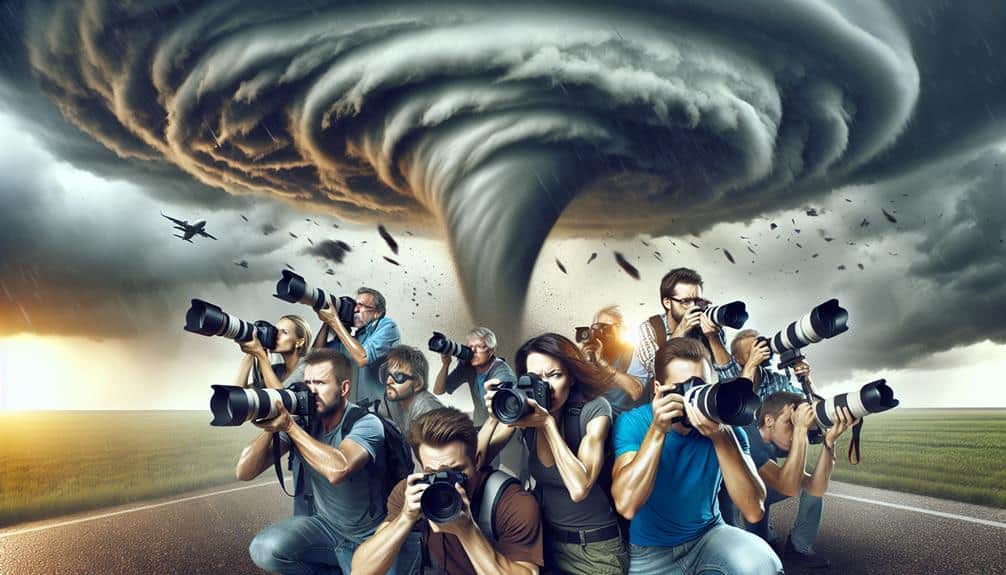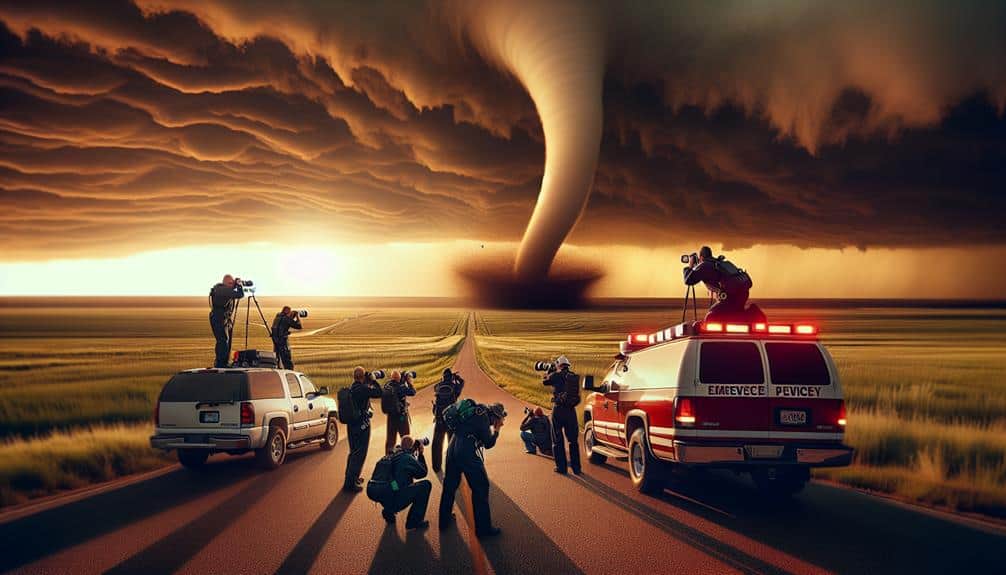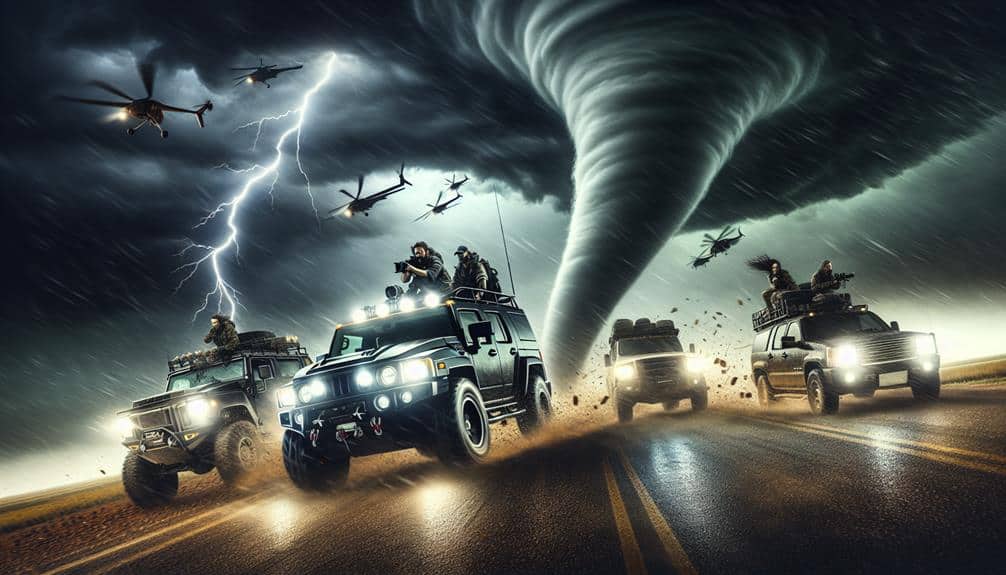We prioritize safety during storm chasing by cross-checking accurate weather forecasts and using reliable communication devices like two-way radios. We equip our vehicles with quality weather radios, GPS, and emergency supplies while maintaining their readiness. Mapping multiple escape routes and planning for contingencies are essential. Staying updated on weather alerts, collaborating with meteorologists, and networking with peers keeps us informed. We continuously monitor conditions, emphasize personal safety, and use analytical risk assessments to guide our actions. For those keen to enhance their storm-chasing protocols, we'll further explore these critical strategies and best practices.
Key Points
- Continuously monitor weather alerts using NOAA radios, mobile apps, and online platforms to stay updated on sudden weather changes.
- Equip your vehicle with high-quality weather radios, GPS systems, and an emergency kit to ensure preparedness and safety during storm chases.
- Plan multiple escape routes using topographical maps and real-time data to avoid getting trapped by severe weather.
- Maintain strong communication with two-way radios, satellite phones, and backup plans to ensure real-time updates and coordination.
Check Weather Forecasts
Before embarking on any storm chasing adventure, we must carefully examine the latest weather predictions from reputable meteorological sources. This step is essential; it provides us with the vital information needed to comprehend upcoming weather patterns. By analyzing these forecasts, we can pinpoint the type, intensity, and path of potential storms. This isn't just about locating the storm; it's about predicting its behavior to safeguard our safety.
Accurate forecasts allow us to develop strong emergency procedures. For example, understanding a storm's projected route helps us identify secure areas and evacuation routes in advance. These procedures are critical for preserving our ability to chase storms while reducing risk. We must be ready for sudden changes in weather patterns, which can transform an exciting chase into a hazardous situation in a moment.
Our analytical approach should involve cross-checking data from various sources, such as satellite images, radar information, and meteorological models. By doing so, we guarantee a thorough understanding of the weather conditions. This diligence in verifying weather predictions is the cornerstone of a successful and safe storm chasing expedition, empowering us to pursue our passion without jeopardizing our well-being.
Use Reliable Communication
Maintaining dependable communication is vital for coordinating with team members and accessing real-time updates during a storm chase. We rely on strong communication devices, such as two-way radios and satellite phones, to guarantee we're always connected, even in remote areas where cellular service is unreliable. These tools allow us to share critical information, such as sudden changes in weather conditions or unexpected hazards, which can be pivotal for our safety.
Emergency protocols are a cornerstone of our communication strategy. We establish clear guidelines on how to report emergencies and the specific steps to take if someone gets separated from the group. This preparation mitigates risks and ensures everyone knows their role in a crisis.
Backup plans are equally important. We don't rely on a single mode of communication; having alternative methods, like portable Wi-Fi hotspots and extra battery packs, is essential. Reliable contacts, such as local emergency services and meteorological centers, are also integrated into our communication plan. By keeping their numbers readily accessible, we can quickly reach out for assistance or updates when needed.
Equip Proper Gear
Equipping ourselves with the proper gear is essential for ensuring both safety and effectiveness during a storm chase. At the core, our gear should include a high-quality weather radio, GPS system, and durable vehicle. These tools aren't just conveniences; they're lifelines.
Ensuring our gear is well-maintained is non-negotiable. Regular gear maintenance checks can prevent malfunctions at critical moments. Inspect our weather radio for signal clarity and keep the GPS updated with the latest maps.
In addition to these basics, we should carry first aid kits, multi-tools, and sufficient food and water supplies. These items support emergency protocols, enabling us to address unforeseen injuries or delays.
Personal protective equipment (PPE) like helmets and reinforced gloves are also essential. They protect us from debris and other hazards, allowing us to focus on the chase instead of potential injuries.
Plan Escape Routes
While our gear guarantees we're well-prepared, mapping out escape routes is essential for safely moving away from escalating storm conditions. We need to identify alternate, accessible routes well in advance to make sure we can evade danger swiftly. This involves detailed pre-trip planning utilizing topographical maps and real-time traffic data to select pathways that remain passable under severe weather conditions.
Our strategy must include:
- Identify multiple egress points: Make sure we've several exit options in different directions to avoid getting trapped by shifting storm paths.
- Establish emergency meeting locations: Designate safe spots where team members can regroup if separated, ensuring everyone's accounted for.
Stay Updated on Alerts
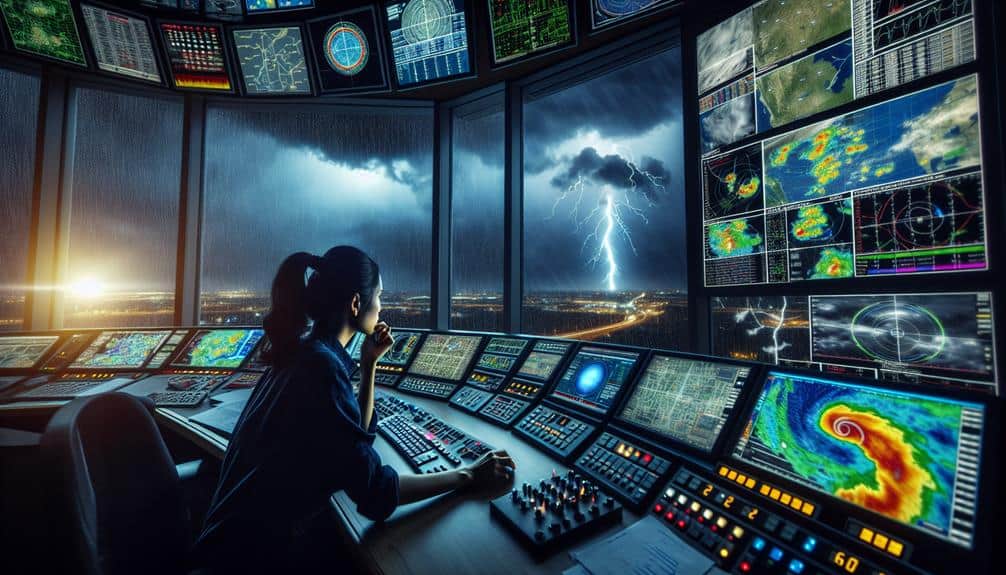
We must continuously monitor weather alerts from reliable sources to stay informed about any sudden changes in storm conditions. Our primary tools should include NOAA weather radios, mobile apps, and online platforms that provide real-time updates. These resources are essential for timely emergency response and ensuring our safety.
By keeping our communication channels open, we can't only safeguard ourselves but also contribute to community support. It's vital to understand the different types of alerts, such as watches and warnings, and to know exactly what actions each necessitates. This knowledge allows us to make swift, informed decisions, reducing our risk exposure.
Moreover, we should set up notifications and automated alerts on our devices. These can be configured to update us on severe weather, tornadoes, flash floods, and other significant conditions. Such preemptive measures enable us to act quickly and efficiently, optimizing our safety protocols.
We should also stay connected with local emergency management agencies and other storm chasers. Sharing real-time information and insights can be invaluable for our collective safety. Essentially, staying updated on alerts isn't just about personal safety; it's about fostering a well-informed, prepared community ready to respond to any emergency.
Avoid High-Risk Areas
We must constantly monitor weather alerts to stay informed about high-risk areas.
By identifying safe zones in advance, we can reduce the likelihood of encountering dangerous situations.
Let's prioritize our safety by avoiding regions with severe weather warnings.
Monitor Weather Alerts
Monitoring weather alerts carefully is important for storm chasers to avoid high-risk areas and ensure safety. By staying informed of the latest weather developments, we can adjust our plans and reduce exposure to dangerous conditions. Integrating real-time data into our decision-making process allows us to react swiftly and evade potential hazards.
To optimize safety, we need robust emergency protocols and thorough safety training. This guarantees everyone knows their role and can act quickly under pressure. Regular drills help reinforce these protocols, keeping them fresh in our minds.
Effective communication strategies are paramount. We should have multiple means to receive weather updates and alerts, such as:
- NOAA Weather Radio for continuous broadcasts.
- Mobile apps that push critical alerts directly to our devices.
We must also maintain up-to-date lists of emergency contacts. These should include local authorities, meteorological services, and our team members. Quick, clear communication can be life-saving in volatile situations.
Identify Safe Zones
Identifying safe zones is vital to minimize exposure to the most dangerous aspects of severe weather. As storm chasers, we must strategically plan our positioning to secure immediate access to safe shelter. This involves conducting a thorough analysis of the area's geography and infrastructure. By pinpointing buildings constructed to withstand severe storms, such as reinforced concrete structures, we enhance our ability to seek refuge quickly.
We can't overlook the significance of evacuation routes. Knowing the quickest paths to safety is pivotal when conditions deteriorate rapidly. We should map out multiple routes in advance, accounting for potential road blockages or flooding. This proactive approach allows us to adapt to changing situations without hesitation.
When selecting safe zones, we must avoid high-risk areas prone to flash flooding, downed power lines, or falling debris. Elevation maps and local topography data can guide us in choosing higher ground, reducing the risk of water-related hazards. By integrating weather radar and GPS technology, we can maintain real-time awareness of severe weather developments, guaranteeing our chosen safe zones remain viable.
In our pursuit of freedom through storm chasing, prioritizing safety by identifying and utilizing safe zones is non-negotiable.
Collaborate With Experts
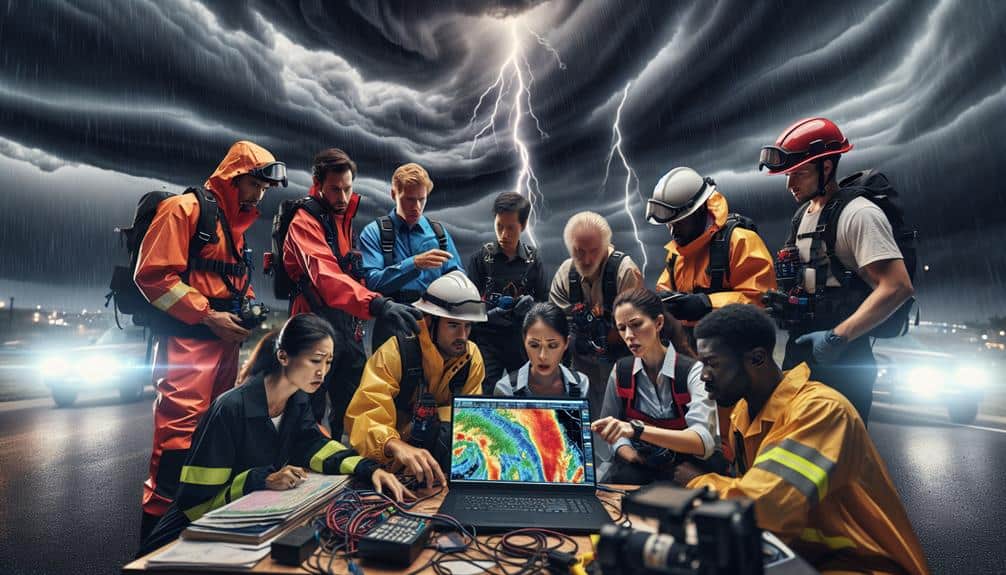
We should network with meteorologists to gain accurate forecasts and real-time updates.
Joining storm chasing groups allows us to share insights and strategies, enhancing our safety and effectiveness.
Network With Meteorologists
Connecting with experienced meteorologists enhances our understanding of storm patterns and improves our decision-making during chases. By establishing meteorologist partnerships, we gain access to advanced storm tracking techniques that are pivotal for effective weather data sharing. This collaboration provides us with real-time updates and safety strategies, ensuring we can make informed choices in the field.
Engaging with meteorologists allows us to:
- Visualize intricate storm patterns: Meteorologists can interpret complex weather data, helping us anticipate storm movements.
- Access exclusive weather tools: High-end radar systems and predictive models are often available through these partnerships.
Our freedom in storm chasing is notably bolstered by these expert collaborations. Meteorologists' insights help us stay ahead of rapidly changing weather conditions, reducing risks and maximizing our ability to capture valuable data. By fostering strong relationships with these experts, we not only enhance our operational efficiency but also contribute to the broader scientific understanding of severe weather phenomena.
Join Storm Chasing Groups
Building on our collaborations with meteorologists, joining storm chasing groups allows us to further enhance our expertise and safety through collective knowledge and experience. These groups provide a structured environment where we can share real-time data, analyze weather patterns, and implement effective safety protocols. By working together, we leverage the diverse skills and insights of seasoned storm chasers, improving our understanding of storm behavior and increasing our chances of staying secure.
Group dynamics play a critical role in our storm chasing endeavors. Effective communication within the group ensures that everyone is aware of the current weather conditions, potential hazards, and the best routes to take. Regular briefings and debriefings keep us aligned on strategies and safety measures, minimizing risks. Each member's unique perspective contributes to a more thorough analysis, enabling more informed decision-making.
Moreover, established storm chasing groups often have access to resources and tools that individual chasers might lack. High-resolution radar, advanced GPS systems, and specialized vehicles are more readily available in a collaborative setting. By joining these groups, we not only enhance our technical capabilities but also create a support network that can be invaluable during critical moments.
Maintain Vehicle Safety
Ensuring our vehicle is in peak condition is vital for safely navigating the unpredictable conditions encountered during storm chasing. Regular vehicle maintenance is our first line of defense against potential breakdowns in remote areas. We must make sure that our tires have sufficient tread, the brakes function properly, and all fluids are topped off.
Keeping an emergency kit in the vehicle, equipped with essentials like jumper cables, first aid supplies, and a spare tire, is essential.
- Tires with sufficient tread
- Fully operational brakes
While maintaining our vehicle is crucial, adopting defensive driving techniques is equally important. Road hazards such as debris, flash floods, and limited visibility can emerge without warning. By staying vigilant and reducing speed in risky conditions, we can avoid accidents and guarantee our safety.
Additionally, it's wise to learn how to handle hydroplaning and skidding, as these are common challenges faced when driving through storm-affected areas.
Monitor Changing Conditions
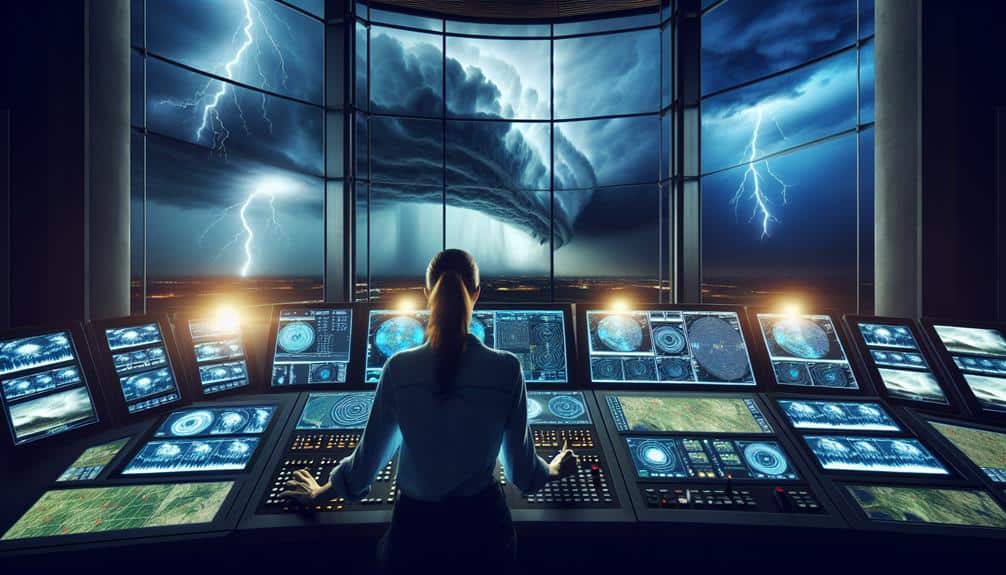
As storm chasers, we must consistently monitor changing conditions to guarantee our safety.
Using reliable weather apps and performing frequent radar checks allows us to stay informed and make timely decisions.
This vigilance helps us anticipate severe weather patterns and avoid dangerous situations.
Use Reliable Weather Apps
We must leverage dependable weather applications to monitor changing conditions accurately and make informed decisions during storm chasing. These applications offer real-time data, essential for tracking storm movements and predicting our next steps. The best ones integrate data from various sources, including the weather channel, providing a thorough storm tracking experience.
Key features to look for in weather applications:
- Real-time updates: Make sure we're always aware of the latest developments.
- Interactive maps: Visualize storm paths and potential impact areas.
By utilizing these tools, we can maximize our situational awareness, helping us stay ahead of rapidly changing conditions.
Applications like RadarScope, Storm Shield, and Weather Underground are excellent choices due to their accuracy and user-friendly interfaces. They allow us to track storms with precision, enhancing our ability to make split-second decisions that prioritize safety and efficiency.
In storm chasing, information is power. Reliable weather applications empower us to venture into the unknown with confidence, knowing we've the latest data at our fingertips. These digital tools are indispensable for anyone passionate about storm chasing while prioritizing safety and well-informed decision-making.
Frequent Radar Checks
Frequent radar inspections are vital for maintaining an up-to-date understanding of storm development and trajectory. By consistently monitoring radar updates, we can anticipate changes in storm intensity and direction, thereby increasing our safety margins. Weather tracking is pivotal; it helps us make informed decisions about positioning and movement.
Radar updates provide real-time data, allowing us to track storm cells, identify potential hazards, and avoid perilous situations. These updates are particularly significant when we're in the field, where conditions can change rapidly. By relying on cutting-edge weather tracking technology, we guarantee our information is current and accurate.
We should use both mobile radar apps and dedicated radar equipment to cross-verify data. This dual approach minimizes the risk of missing crucial information. Additionally, setting regular intervals for radar checks—every 10 to 15 minutes, for instance—allows us to stay one step ahead of the storm.
Incorporating frequent radar checks into our routine not only enhances our situational awareness but also empowers us to take proactive measures. This disciplined approach to monitoring changing conditions isn't just a best practice; it's a necessity for any storm chaser committed to safety and freedom.
Prioritize Personal Safety
Ensuring personal safety should always be the primary focus for storm chasers, emphasizing the importance of proper equipment, situational awareness, and adherence to safety protocols. We can't stress enough the need for thorough safety training. This foundational knowledge prepares us for emergency response situations, ensuring that we can act swiftly and correctly when faced with danger.
Risk assessment is another critical component. Before heading out, we should evaluate all potential hazards and establish clear safety protocols. This analytical approach helps in making informed decisions that minimize risk while maximizing our ability to track storms effectively.
To visualize these concepts, consider the following:
- Safety Gear: Imagine a well-equipped storm chaser with a sturdy helmet, reinforced clothing, and a reliable weather radio.
- Situational Awareness: Picture us constantly scanning the horizon, monitoring radar updates, and communicating with team members to stay informed about changing conditions.
Frequently Asked Questions
What Are the Legal Regulations for Storm Chasing in Various States?
Sailing through the stormy waters of state regulations, we discover licensing requirements vary greatly. Some states have strict rules, while others offer more flexibility. It's essential that we grasp each state's specific laws before pursuing the excitement.
How Do Insurance Policies Cover Storm Chasing Activities?
When discussing insurance coverage for storm chasing, we must analyze liability concerns. Policies vary, but most standard plans don't cover high-risk activities. Specialized insurance might be necessary to guarantee we're protected against potential damages and injuries.
What Are the Best Practices for Documenting Storms Safely?
Sailing through the storm's fury, we prioritize equipment preparation and safety protocols. Effective communication and emergency response plans are essential. Let's make sure our gear's ready, follow strict guidelines, and maintain constant contact to document storms safely.
How Can You Manage Stress and Anxiety During Intense Storm Conditions?
We can manage stress and anxiety during intense storm conditions by employing self-care strategies and coping mechanisms. Focusing on mental health through mindfulness practices helps us stay centered, thereby maintaining our freedom to operate effectively.
What Are the Ethical Considerations When Encountering Affected Communities?
When storm clouds clear, we must tread lightly. Our community engagement should prioritize cultural sensitivity, respecting local customs and needs. Let's remember, their freedom to rebuild and recover is our ethical responsibility.
